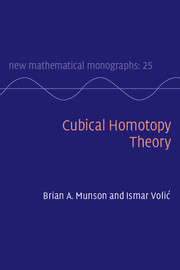Book contents
- Frontmatter
- Dedication
- Contents
- Preface
- PART I CUBICAL DIAGRAMS
- 1 Preliminaries
- 2 1-cubes: Homotopy fibers and cofibers
- 3 2-cubes: Homotopy pullbacks and pushouts
- 4 2-cubes: The Blakers–Massey Theorems
- 5 n-cubes: Generalized homotopy pullbacks and pushouts
- 6 The Blakers–Massey Theorems for n-cubes
- PART II GENERALIZATIONS, RELATED TOPICS, AND APPLICATIONS
- Appendix
- References
- Index
4 - 2-cubes: The Blakers–Massey Theorems
from PART I - CUBICAL DIAGRAMS
Published online by Cambridge University Press: 05 October 2015
- Frontmatter
- Dedication
- Contents
- Preface
- PART I CUBICAL DIAGRAMS
- 1 Preliminaries
- 2 1-cubes: Homotopy fibers and cofibers
- 3 2-cubes: Homotopy pullbacks and pushouts
- 4 2-cubes: The Blakers–Massey Theorems
- 5 n-cubes: Generalized homotopy pullbacks and pushouts
- 6 The Blakers–Massey Theorems for n-cubes
- PART II GENERALIZATIONS, RELATED TOPICS, AND APPLICATIONS
- Appendix
- References
- Index
Summary
The last chapter explored two different definitions of “equivalence” of 1-cubes, or maps of spaces. These are the notions of a homotopy cartesian and homotopy cocartesian square. In Section 3.9 we were essentially combining the two notions. The Blakers–Massey Theorem (also known as the Triad Connectivity Theorem) and its dual are theorems which directly compare these, giving an idea to what degree a homotopy cocartesian square is homotopy cartesian and vice versa.
The Blakers–Massey Theorem has far-reaching consequences in homotopy theory and many classical results follow from it. For example, we will in this chapter use the Blakers–Massey Theorem to deduce the Freudenthal Suspension Theorem, Serre's Theorem, the (Relative) Hurewicz Theorem, and the Homological Whitehead Theorem. It should also be noted that the proof of the Blakers–Massey Theorem we give here is different than any other one we know of in the literature, although it follows the ideas of Goodwillie [Goo92] closely.
The general Blakers–Massey Theorem will be proved in Chapter 6.
Historical remarks
The original motivation for the work Blakers and Massey did in [BM49, BM51, BM52, BM53a, BM53b] is the simple observation that homology groups satisfy excision while homotopy groups do not. Namely, if a space X is a union of two subspaces A and B, then, under some mild hypotheses, the inclusions
(A, A ∩ B) → (X, B)
(B, A ∩ B) → (X, A)
induce isomorphisms on relative homology groups. However, this is not true for homotopy groups (take e.g. X = S2 with A and B two hemispheres intersecting in a circle). Nevertheless, the Blakers–Massey Theorem states that excision for homotopy groups is satisfied through a range that depends on the connectivities of the pairs of spaces. The early version of this theorem is given below as Theorem 4.1.1. We include this as a convenient starting point for a brief discussion on the history of this theorem, but our preferred statement is Theorem 4.2.1, which is also more general.
Recall from Definition 2.6.4 the notion of the connectivity of a pair (X, A). We then have the following.
Theorem 4.1.1 (Blakers–Massey or homotopy excision) Suppose X is a union of two open subspaces A and B such that A, B, and A ∩ B are path-connected. Suppose (A, A ∩ B) is k1-connected and (B, A ∩ B) is k2-connected, with k1, k2 ≥ 1.
- Type
- Chapter
- Information
- Cubical Homotopy Theory , pp. 183 - 220Publisher: Cambridge University PressPrint publication year: 2015



